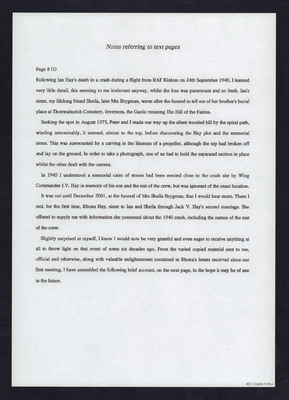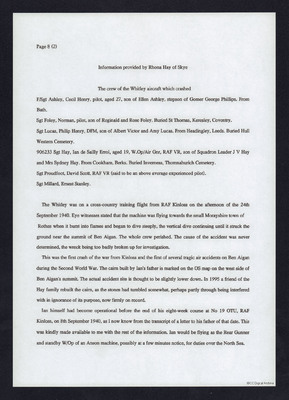Notes referring to text pages
Title
Notes referring to text pages
Description
Retrospective after the death in a crash during a flight from RAF Kinloss on 24 September 1940. Author knew Ian Hay's sister well and writes of visiting his grave in Inverness. Mentions cairn raise by Hay's father near crash site and finding out more about the crash at the funeral of his sister in 2001. Goes on with information provided by Rhona Hay at this occasion including listing of the crew and a short description of the flight and the crash. Mentions that there were several other subsequent crashes in same location and gives some details of the cairn raised near site of crash.
Coverage
Language
Type
Format
Two page printed document
Conforms To
Publisher
Rights
This content is available under a CC BY-NC 4.0 International license (Creative Commons Attribution-NonCommercial 4.0). It has been published ‘as is’ and may contain inaccuracies or culturally inappropriate references that do not necessarily reflect the official policy or position of the University of Lincoln or the International Bomber Command Centre. For more information, visit https://creativecommons.org/licenses/by-nc/4.0/ and https://ibccdigitalarchive.lincoln.ac.uk/omeka/legal.
Contributor
Identifier
SFieldPL907804v10029-0001, SFieldPL907804v10029-0002
Transcription
Notes referring to text pages
Page 8 (1)
Following Ian Hay’s death in a crash during a flight from RAF Kinloss on 24th September 1940, I learned very little detail, this seeming to me irrelevant anyway, whilst the loss was paramount and so fresh. Ian’s sister, my lifelong friend Sheila, later Mrs Brygman, wrote after the funeral to tell me of her brother’s burial place at Thomnahurich Cemetery, Inverness, the Gaelic meaning The Hill of the Fairies.
Seeking the spot in August 1975, Peter and I made our way up the silent wooded hill by the spiral path, winding interminably, it seemed, almost to the top, before discovering the hay plot and the memorial stone. This was surmounted by a carving in the likeness of a propeller, although the top had broken off and lay on the ground. In order to take a photograph, one of us had to hold the separated section in place whilst the other dealt with the camera.
In 1945 I understood a memorial cairn of stones had been erected close to the crash site by Wing Commander J.V. Hay in memory of his son and the rest of the crew, but was ignorant of the exact location.
It was not until December 2001, at the funeral of Mrs Sheila Brygman, that I would hear more. There I met, for the first time, Rhona Hay, sister to Ian and Sheila through Jack V. Hay’s second marriage. She offered to supply me with information she possessed about the 1940 crash, including the names of the rest of the crew.
Slightly surprised at myself, I knew I would now be very grateful and even eager to receive anything at all to throw light on that event of some six decades ago. From the varied copied material sent to me, official and otherwise, along with valuable enlightenment contained in Rhona’s letters received since our first meeting, I have assembled the following brief account, on the next page, in the hope it may be of use in the future.
[page break]
Page 8 (2)
Information provide by Rhona Hay of Skye
The crew of the Whitley aircraft which crashed
F/Sgt Ashley, Cecil Henry, pilot, aged 27, son of Ellen Ashley, stepson of Gomer George Phillips. From Bath.
Sgt Foley, Norman, pilot, son of Reginald and Rose Foley. Buried St Thomas, Keresley, Coventry.
Sgt Lucas, Philip Henry, DFM, son of Albert Victor and Amy Lucas. From Headingley, Leeds. Buried Hull Western Cemetery.
906233 Sgt Hay, Ian de Sailly Errol, aged 19, W.Op/Air Gnr, RAF VR, son of Squadron Leader J V Hay and Mrs Sydney Hay. From Cookham, Berks. Buried Inverness, Thomnahurich Cemetery.
Sgt. Proudfoot, David Scott, RAF VR (said to be an above average experienced pilot).
Sgt Millard, Ernest Stanley.
The Whitley was on a cross-country training flight from RAF Kinloss on the afternoon of the 24th September 1940. Eye witnesses stated that the machine was flying towards the small Morayshire town of Rothes when it burst into flames and began to dive steeply, the vertical dive continuing until it struck the ground near the summit of Ben Aigan. The whole crew perished. The cause of the accident was never determined, the wreck being too badly broken up for investigation.
This was the first crash of the war from Kinloss and the first of several tragic air accidents on Ben Aigan during the Second World War. The cairn built by Ian’s father is marked on the OS map on the west side of Ben Aigan’s summit. The actual accident site is thought to be slightly lower down. In 1995 a friend of the Hay family rebuilt the cairn, as the stones had tumbled somewhat, perhaps partly through being interfered with in ignorance of its purpose, now firmly on record.
Ian himself had become operational before the end of his eight-week course at No 19 OTU, RAF Kinloss, on 8th September 1940, as I now know from the transcript of a letter to his father of that date. This was kindly made available to me with the rest of the information. Ian would be flying as the Rear Gunner and standby W/Op of an Anson machine, possibly at a few minutes notice, for duties over the North Sea.
Page 8 (1)
Following Ian Hay’s death in a crash during a flight from RAF Kinloss on 24th September 1940, I learned very little detail, this seeming to me irrelevant anyway, whilst the loss was paramount and so fresh. Ian’s sister, my lifelong friend Sheila, later Mrs Brygman, wrote after the funeral to tell me of her brother’s burial place at Thomnahurich Cemetery, Inverness, the Gaelic meaning The Hill of the Fairies.
Seeking the spot in August 1975, Peter and I made our way up the silent wooded hill by the spiral path, winding interminably, it seemed, almost to the top, before discovering the hay plot and the memorial stone. This was surmounted by a carving in the likeness of a propeller, although the top had broken off and lay on the ground. In order to take a photograph, one of us had to hold the separated section in place whilst the other dealt with the camera.
In 1945 I understood a memorial cairn of stones had been erected close to the crash site by Wing Commander J.V. Hay in memory of his son and the rest of the crew, but was ignorant of the exact location.
It was not until December 2001, at the funeral of Mrs Sheila Brygman, that I would hear more. There I met, for the first time, Rhona Hay, sister to Ian and Sheila through Jack V. Hay’s second marriage. She offered to supply me with information she possessed about the 1940 crash, including the names of the rest of the crew.
Slightly surprised at myself, I knew I would now be very grateful and even eager to receive anything at all to throw light on that event of some six decades ago. From the varied copied material sent to me, official and otherwise, along with valuable enlightenment contained in Rhona’s letters received since our first meeting, I have assembled the following brief account, on the next page, in the hope it may be of use in the future.
[page break]
Page 8 (2)
Information provide by Rhona Hay of Skye
The crew of the Whitley aircraft which crashed
F/Sgt Ashley, Cecil Henry, pilot, aged 27, son of Ellen Ashley, stepson of Gomer George Phillips. From Bath.
Sgt Foley, Norman, pilot, son of Reginald and Rose Foley. Buried St Thomas, Keresley, Coventry.
Sgt Lucas, Philip Henry, DFM, son of Albert Victor and Amy Lucas. From Headingley, Leeds. Buried Hull Western Cemetery.
906233 Sgt Hay, Ian de Sailly Errol, aged 19, W.Op/Air Gnr, RAF VR, son of Squadron Leader J V Hay and Mrs Sydney Hay. From Cookham, Berks. Buried Inverness, Thomnahurich Cemetery.
Sgt. Proudfoot, David Scott, RAF VR (said to be an above average experienced pilot).
Sgt Millard, Ernest Stanley.
The Whitley was on a cross-country training flight from RAF Kinloss on the afternoon of the 24th September 1940. Eye witnesses stated that the machine was flying towards the small Morayshire town of Rothes when it burst into flames and began to dive steeply, the vertical dive continuing until it struck the ground near the summit of Ben Aigan. The whole crew perished. The cause of the accident was never determined, the wreck being too badly broken up for investigation.
This was the first crash of the war from Kinloss and the first of several tragic air accidents on Ben Aigan during the Second World War. The cairn built by Ian’s father is marked on the OS map on the west side of Ben Aigan’s summit. The actual accident site is thought to be slightly lower down. In 1995 a friend of the Hay family rebuilt the cairn, as the stones had tumbled somewhat, perhaps partly through being interfered with in ignorance of its purpose, now firmly on record.
Ian himself had become operational before the end of his eight-week course at No 19 OTU, RAF Kinloss, on 8th September 1940, as I now know from the transcript of a letter to his father of that date. This was kindly made available to me with the rest of the information. Ian would be flying as the Rear Gunner and standby W/Op of an Anson machine, possibly at a few minutes notice, for duties over the North Sea.
Collection
Citation
“Notes referring to text pages,” IBCC Digital Archive, accessed November 8, 2024, https://ibccdigitalarchive.lincoln.ac.uk/omeka/collections/document/37193.
Item Relations
| Item: Accompanying note | dcterms:relation | This Item |


